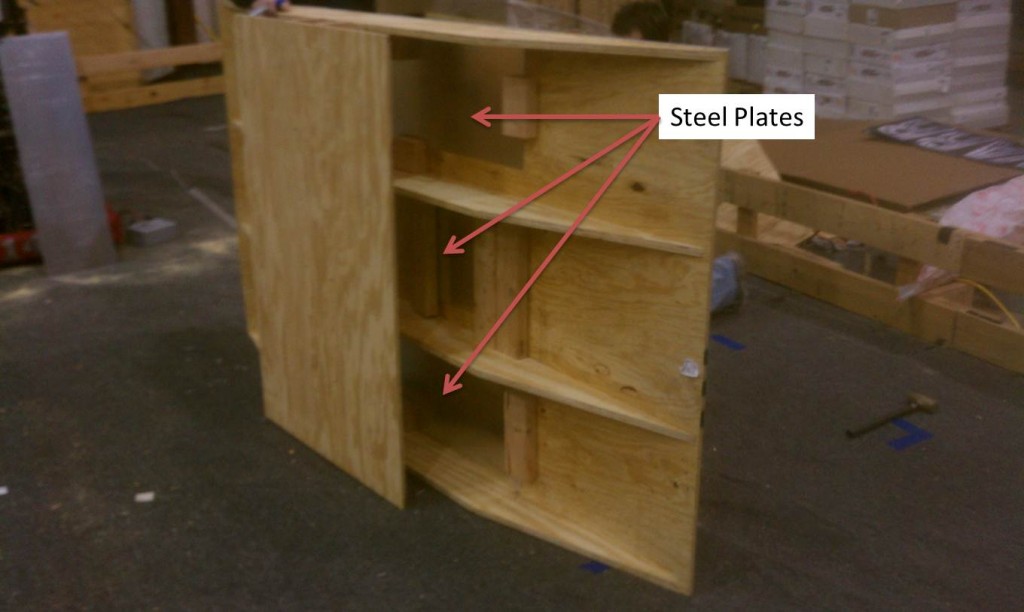Ramp Dynamics
More progress was made on many different prototypes today….but I am sure none of you all are interested in what team 148 is building so I am going to take this opportunity to talk about something else.
As my previous post indicated we had been busy trying to make sure our practice field is as true to reality as possible. We made some giant leaps forward when we got the basketball hoops in and our sheet metal barriers back from the shop. The last thing left to do was the ramps and more directly how to make sure the ramps function like the ones on the real field.
I noticed a bit of conversation on www.chiefdelphi.com on how to do this so I thought I would share our method.
On Kickoff FIRST posted this video.
If you ignore the extremely dry puns the most important info comes when they talk about the balance test. 2 FRC batteries 28″ from one side should not tip the bridge, while moving them to 30″ will. We found that our bridge as built to the plans was no where close, so we brainstormed and figured out how to fix it.
Our bridge had 2 distinct problems. 1) the balancing point on each side of center was not the same on either side of the bridge and 2) the tip points were totally off from the FIRST spec.
To fix problem one we took 2 FRC batteries and determined the point away from the center which would cause the ramp to tip (ours was something like a single battery 14 inches from center on one side and a single battery 22 inches away on the other side. This inequality is simply a Torque balancing problem. Distance X Force (battery Weight) of the larger side – the smaller side Then divide by 2, That number is your difference. If you remove the weight of the battery by dividing it out Subtract that number from the side that has the higher torque value and you will get the amount which you must adjust the ramp.
In our case 22 inches X 13.5lbs = 297 in-lbs and 14 inches x 13.5 lbs = 189 in-lbs Difference = 108 in-lbs Difference/2 = 54 in-lbs removing the weight 54/13.5= 4 inches. So we needed to add 13.5 lbs to the ramp 4 inches from the central pivot. In actuality you can assume that the weight is just 1 unit and figure it all out with just the distance differences. ((22-14)/2)=4 But then you don’t have the amount of weight to use, so even if the weight gets canceled out in your equation, it is still a constant that you need. We used batteries and calculated this with 1 BMU (battery mass unit)
Once we got the ramp balancing correctly we still had the issue of it tipping too quickly. This is due to the entire system being too light. The system mass is important because balanced weight will impact how much force is required to initiate movement. This is a system dynamics problem where you are trying to solve a problem at the edge of equilibrium. I wish I could give you a formula to work on your bridge but our solution was much simpler than that, we cut steel plates and kept adding them to the underside of the bridge until it balanced like the video. Nothing special, just some trial and error. Ours took about 20lbs.
Hope this helps you out.
On a side note, the way that the real bridges are designed will have this same inequality from left to right, does anyone know if FIRST will balance the ramps out?

We ran into this problem too. Tried figuring out some math but it didn’t work out in practice.
Jeff,
Ours was close to the math. The trick is to balance the ramp side to side before increasing the mass. Make sure the ramp is completely built, with lexan and all before doing this.
Greg
I don’t know how significant this will be, since we haven’t finished building ours and we haven’t gotten a chance to test yet, but if you think about it, there actually is no single center axis of rotation, but rather two of them. Given the shift in moment of inertia and the torque, the two inches may/may not have an effect on tipping.
Sam,
That’s exactly why experimental solutions to this are the only way to fix it. Also the reason why FIRST said that moving the batteries from 28″ to 30″ causes the ramp to move. There is a tolerance range on when the ramp will tip. It will be interesting to see what happens during the game when teams are almost balanced and then cross this threshold.
Greg